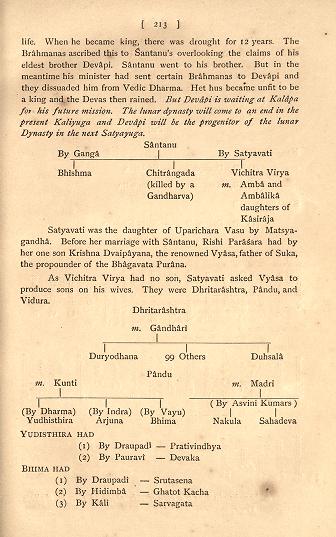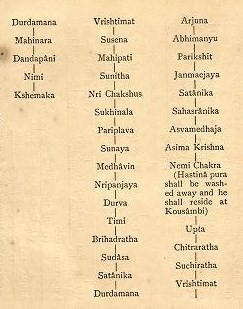Arjuna
| Author:Laxman Burdak, IFS (R) |


Arjuna (अर्जुन) is one of the heroes of the epic Mahabharata. His name means 'bright', 'shining', or 'silver'. The third of the five Pandava brothers, Arjuna was one of the children borne by Kunti, first wife of Pandu.
Variants
- Partha (पार्थ) - Partha is other name of Arjuna derived from Pritha meaning son of Pritha. अर्जुन का ही दूसरा नाम है भगवान श्री कृष्णा ने अर्जुन को पार्थ ही सम्बोधन दिया था ।महाभारत के युद्ध में श्री भगवत गीता का ज्ञान देते समय। इसलिए कुछ तोमर जाट पार्थ को उपनाम के रूप में काम लेते है क्योकि तोमर जाट पाण्डुवंशी अर्जुन के ही वंशज हैं।
Birth and early years
Once, a Brahmin rishi named Kindama and his wife were making love in the forest when Arjuna's father Pandu accidentally shot at them, mistaking them for deer. Before dying, Kindama cursed the king to die when he engages in intercourse. Due to this curse, Pandu was unable to father children. As an additional penance for the murder, Pandu abdicated the throne of Hastinapura and his blind brother Dhritarashtra took over the reins of the kingdom.
After Pandu's disability, the Pandavas were conceived in an unusual way. His mother, Queen Kunti, had in her youth been granted the power to invoke the Devas by Rishi Durvasa. Each Deva, when invoked, would bless her with a child. Urged by Pandu to use her boons, Kunti gave birth to Arjuna by invoking the Lord of Heaven, Indra. King Pandu and Kunti purified themselves by severe austerities to Indra for one year before he was born. No other birth in the Mahabharata except Krishna's was celebrated by the devas, sages and apsaras.
Along with other Pandava brothers, Arjuna was trained in religion, science, administration and military arts by the Kuru preceptors, Kripa and Drona. Specifically, he became a master in using the bow and the arrow. He was the best archer except a Kirant prince called [[Eklabya whom Drona tricked into vowing never to raise a bow. Arjuna's strength lay in his extraordinary levels of concentration. In a famous incident under Drona's tutelage, Drona deemed none of his students other than Arjuna had the steadfast focus to shoot a bird on a tree and was proved right by Arjuna. In those times Jatrii Kśatriya and Abhira (Ahir) Kśatriya, frequently fought each other. Kriśhńa thought, if he united these two tribes, it would be very easy for Him to bring about Great India. He applied His practical approach. He got his younger sister, Subhadra, an Ábhira Kśatriya, to marry Arjuna who was a Jat.[1] This He did with a view to make the Játrii Kśatriyas and the Ábhiira Kśatriyas stop fighting.[2]
Arjuna's Tirtha-yatra
Meeting Ulupi: Arjuna started his pilgrimage by visiting the source of river Ganga. It was here that he accidentally met the Naga princess, Ulupi. She was deeply infatuated by him and the couple were drawn into days of passionate love-making. Before departing, Ulupi granted him the boon of invincibility in water bodies. Iravan was Arjuna's son with Ulupi.
Chitrangadaa at Manipura: Arjuna visited other Tirthas in India, including Kalinga and the ashrams of the Saptarishis, Agastya, Vasishta and Bhrigu. Finally he reached the palace of Manipura. Here he met king Chitravahana's daughter, Chitrangada. He fell in love with her and requested the king for his daughter's hand in marriage. The king readily agreed on finding out Arjuna's real identity, but sought a promise from Arjuna that their son would remain in Manipura and take over the reins of the kingdom succeeding him. Arjuna agreed, and later spent time in the palace till the birth of his son, Babruvahana. Then Arjuna again visited Manipur and crowned Babruvahana as the king.
Reaching Dwarka and Subhadra: Arjuna moved to other Tirthas, including the southern regions in Kerala. Finally he reached Dwarka, the place where his cousin Krishna resided. Arjuna had, in his childhood, heard about Krishna's beautiful sister, Subhadra. Now he was in Dwarka, he felt an intense longing to see her. Krishna knew of Arjuna's yearning and devised a plan to arrange their meet. Accordingly Arjuna disguised himself as a “yati” and stayed at Subhadra's palace. Soon the couple managed to fall in love. They spent a year together in Dwarka. Later they moved to a small ashram in Pushkara where they stayed for another year, before moving to Indraprastha. After a few years Abhimanyu was born to Arjuna and Subhadra.
Burning of Khandava Vana: Once when roaming in the Khandava Vana, Arjuna and Krishna met the god of fire, Agni. Agni was in great hunger and needed to burn down the entire Khandava Vana to quench his hunger. But Takshaka, the serpent-king lived in the same forest and was a friend of Indra's. So the latter brought down heavy rains to thwart Agni's plans to burn the woods. Agni requested Krishna and Arjuna to help him realize his goal.
The three of them then invoked Varuna, the God of the oceans, who blessed them with the Gandiva – the moon bow created by Brahma. Agni also gave Arjuna an incandescent chariot with four horses yoked and bearing a flag of Hanuman. Arjuna uses the weapon and chariot to fight the Kurukshetra War during the later parts of the epic. Agni presented Krishna with the Sudarshana Chakra. Together with these weapons, Arjuna and Krishna waged a successful battle against Indra and helped Agni burn down the entire Khandava Vana including all its demons and evil spirits.
Saving Mayasura: In their demolition of Khandava Krishna and Arjuna had saved one demon, Mayasura. Mayasura told that he would build a palace for Yudhishtra because Arjuna had saved him from krishna and Agni. As Mayasura was a great architect, he soon constructed the Maya assembly hall – a gigantic palace for the Pandavas in Indraprastha.
Arjuna's Conquest
Arjuna was sent north by Yudhisthira to subjugate kingdoms for the Rajasuya Yagya, after crowning as the Emperor of Indraprastha.Sabha Parva, Mahabharata/Book II Chapter 24 & Sabha Parva, Mahabharata/Book II Chapter 25 tell us countries Arjuna subjugated. The list includes: Antargiri (अन्तरगिरि) Abhisari (town) (अभिसारी), Bahiragiri (बहिर्गिरि) Balhikas (बाह्लीक), Chitrayudha (चित्रायुध) Chola (चॊला), Daradas (दरद), Darvas (दार्व), Devaprastha (देवप्रस्थ), Gandharvas (गन्धर्व), Guhyakas (गुह्यक), Harivarsha (हरिवर्ष), Hataka (हाटक), Hivavant (हिमवन्त), Kambojas (काम्बॊज), Kashmira (काश्मीर), Kirita (किरीटी), Kokonadas (कॊकनद), Kuluta (कुलूतान), Limpurushas (), Lohas (लॊह), Lohita (लॊहित), Manasa (मानस), Modapura (मॊदापुर), Nishkuta (निष्कुट), Northern Ulukas (?), Paurava (पौरव), Pragjyotisha (प्राग्ज्यॊतिष), Rishikas (ऋषिक), Sakraprastha (city) () Senabindu (सेनाबिन्दु), Shakyapura (शक्यपुर) Singhapura (town) (सिंहपुर), Sudaman (सुदामा), Suhma (सुह्म), Sumala (), Susankula (सुसंकुलम), Taraka (तारक), Trigartas (त्रिगर्त), Uraga (उरग), Utsava-Sanketa (उत्सव संकेत), Uttara (उत्तर), Vamadeva (वामदेव), Vishvaga (विष्वग)
Son of Arjuna
- Abhimanyu: A single son, Abhimanyu, was born to Arjuna and Subhadra. Parikshita, (son of Abhimanyu and Uttarā,born after Abhimanyu was killed in the battlefield], was destined to be the sole surviving dynast of the entire Kuru clan, and succeeded Yudhistra as the emperor of Pandava kingdom.
- Iravan from Naga wife Ulupi
- Babruvahan from Naga wife Chitrangada
Arjun tribe
Arjun is the name of a Pandu tribe in Afghanistan. [3]
Mention by Panini
Arjuna (अर्जुन) is a term mentioned by Panini in Ashtadhyayi. [4]
Arjuna (अर्जुन) is name of a place mentioned by Panini in Ashtadhyayi under Trinadi (तृणादि) (4.2.80.2) group. [5]
Arjuna (अर्जुन) is name of a place mentioned by Panini in Ashtadhyayi under Sutangamadi (सुतंगमादि) (4.2.80.14) group. [6]
Jat History
Hukum Singh Panwar (Pauria) [7] writes: Investigations show that the Sobii, Sophites, Kathai & Malli, being cognate tribes, were intimately connected with each other and also with the Gakhars and Taxili (Takasali or the Takkas or Takshakas). Daci (Daki in Jatu dialect) and Dacia of Roman history or Dasyu of Sanskrit or Dasae of Stephen us Byzantinus are Dahae or Tahae of the Chinese, a tribe of the eastern Scythians, the Massagetae. Meds or Medi or Mand or Mind or Mandrueni or Mandueni or Mers or Moedi of Strabo (enemies of Jats) still found in the Rechna and Sindh-Sagar Doabas, were the first Indo-Scythian conquerors of the Punjab from Mandrus river to the South of the Oxus or they were Thracian Getae. The Mogas or Mogars, founder of Moga or Moog-nagar on the east bank of the Jhelam, were the Parthians, descendents of Prithu, an important section of the Sakas. Interestingly, Arjuna, the Pandava hero in the Mahabharata war, is addressed by Krishna, his charioteer friend, as Partha. Prithudaka (modern Pehowa) in the Kurukshetra region was, according to O.P. Bharadvaja (1986: 197f), the original home of Prithus or Parthas. The ancient Parthia must have owed its name to the Parthian emigrants from the eastern part of Sapta Sindhu.
पार्थ
पार्थ अर्जुन का ही दूसरा नाम है भगवान श्री कृष्णा ने अर्जुन को पार्थ ही सम्बोदन दिया था ।महाभारत के युद्ध में श्री भगवत गीता का ज्ञान देते समय । इसलिए कुछ तोमर पार्थ को उपनाम के रूप में काम लेते है क्योकि तोमर जाट पाण्डुवंशी अर्जुन के ही वंशज है .
इतिहास
विजयेन्द्र कुमार माथुर[8]ने लिखा है .... हाटक (AS, p.1018): महाभारत सभापर्व में उल्लिखित स्थान है, जिसे यक्षों का देश कहा गया है. इस पर उत्तर दिशा की दिग्विजय के प्रसंग में अर्जुन ने विजय प्राप्त की थी- यह स्थान कालिदास के मेघदूत की अलका के निकट ही स्थित होगा. मानसरोवर यहां से समीप ही था- यह तिब्बत में स्थित वर्तमान मानसरोवर और कैलाश का निकटवर्ती प्रदेश था. यहां गुहयकों (यक्षों) तथा गंधर्वों की बस्ती था. श्री बी.सी. ला के मत में हाटक वर्तमान अटक (पाकिस्तान) है. एन.ल. डे के अनुसार यह हूण देश का नाम है.
जाट इतिहास
डॉ रणजीतसिंह[9] लिखते हैं...जाटों के विषय में सर्वप्रथम जानकारी देने वाले हेरोडोटस थे। इन्होंने अपने यात्रा विवरणों के अध्ययन के आधार पर यह लिखा है कि प्रथम दारा के पुत्र जरक्सीज के यूनान पर आक्रमण के समय उसके साथ भारतीय जाटों का दल था। इसी प्रकार बहुत से विद्वान भागवत और महाभारत के आधार पर यह मानते हैं कि अर्जुन के साथ में द्वारिका से आने वाला यादव कुलीन जाटों का समूह था और यह परिवार (जाट) घुमक्कड़ कबीलों के रूप में भारतीय सीमाओं से बाहर इधर-उधर बिखर गया। सिकंदर के आक्रमणों के बाद ईसाई तथा मुस्लिम संघर्षों के बाद वे पुनः ईरान के मार्ग से भारत में लौट आए। इस प्रकार के जाट पच्छान्दे कहलाते हैं। इलियट तथा डाउसन के विचार में इस्लाम धर्म की स्थापना के समय सिंधु प्रांत (शाक द्वीप) में जाट शक्ति का बोलबाला था। इस प्रांत के जाट शासक जागीरदार तथा उपजाऊ भूमि के स्वामी होने के साथ-साथ वैदिक संस्कृति के पोषक भी थे और वे आत्मा के अमरत्व में विश्वास करते थे।
References
- ↑ [1]
- ↑ [2]
- ↑ An Inquiry Into the Ethnography of Afghanistan By H. W. Bellew, The Oriental University Institute, Woking, 1891, p.81
- ↑ V. S. Agrawala: India as Known to Panini, 1953, p.340
- ↑ V. S. Agrawala: India as Known to Panini, 1953, p.504
- ↑ V. S. Agrawala: India as Known to Panini, 1953, p.507
- ↑ Hukum Singh Panwar (Pauria): The Jats:Their Origin, Antiquity and Migrations/The identification of the Jats,p.324
- ↑ Aitihasik Sthanavali by Vijayendra Kumar Mathur, p.1018
- ↑ Jat Itihas By Dr Ranjit Singh/1.Jaton Ka Vistar,p.5
Back to The Ancient Jats

